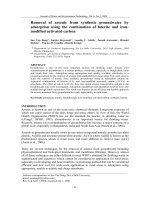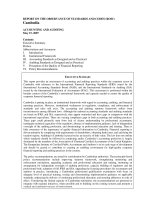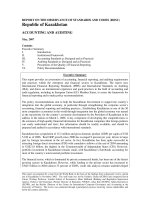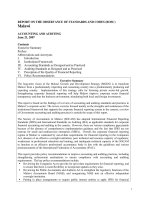research report 'using the activity in pairs and in groups to teach writing in english'
Bạn đang xem bản rút gọn của tài liệu. Xem và tải ngay bản đầy đủ của tài liệu tại đây (78.04 KB, 4 trang )
§¹i häc Vinh T¹p chÝ khoa häc, tËp XXXVI, sè 2b-2007
89
USING PAIR WORK AND GROUP WORK IN
TEACHING ENGLISH WRITING
NguyÔn ThÞ T−êng
(a)
Abstract. The techniques that we covered in our writing class were centered on
using pair and group work to increase active student participation. By using this
method for teaching the first year students, we have got many benefits in teaching
and learning English writing. Therefore, we would like to introduce some writing
games for using pair work and group work in order to help the teachers teach
English writing more effectively.
I. A COMMUNICATIVE ON
WRITING SKILLS
Writing is an instrument of both
communication and self-expression.
Most people, however, especially when
writing in a foreign or second language,
use it primarily to communicate with
other members of their own community
or the wider world. Our main task is
therefore to teach effective functional
writing rather than creative self-
expression. Andrew Little (1991)
suggested a few initial guiding
principles to note:
• Writing should be as close as
possible to genuine functional use of
language, as opposed to the traditional
set-piece classroom composition for the
eyes of the teacher only.
• Since people’s ways of
communicating information are very
varied, there is no single way of writing
correct English. It is therefore
important for students to read as
widely as possible in order to become
familiar with different varieties of
written English. They cannot be
expected to write in a style which they
have never seen or read.
• Good writing depends on a set of
specific writing skills. It does not follow
automatically from good grammar and
adequate vocabulary.
II. BENEFITS OF USING PAIR
WORK AND GROUP WORK IN
TEACHING WRITING
A writing game is one type of
language games in which students
work together, in pair or small groups.
Most language games are to reinforce
the language already taught or
acquired and to allow students to
practise the language they are learning
in a more interesting way.
The use of group work (which
includes writing games) might at first
sight appear inappropriate for the
teaching of writing. In general,
however, group work means that there
is some kind of cooperation between the
members of the class, who are divided
into conveniently-sized groups for the
purpose. They might be discussing
something in pairs before starting to
write; they might play involving two
teams; they might split responsibility
among different students so that one
student collects information, another
organises it and a third actually writes
whatever has to be written.
NhËn bµi ngµy 30/3/2007. Söa ch÷a xong 09/8/2007.
§¹i häc Vinh T¹p chÝ khoa häc, tËp XXXVII, sè 2b-2007
90
Even when group work is not explicitly
mentioned in the exercises, teachers
should encourage it whenever possible.
Moreover, group work can go
beyond preparation for writing. The
members of a pair, or larger group, can
actually do the writing together. They
can discuss the exact words and
sentences to be used, and then either
each student writes down what was
said, or else they appoint one member
of the group to be the writer for all of
them. It is always important for the
teacher to move fairly around the room,
helping each group with vocabulary,
making sure everyone is involved, but
not staying too long with any group
since the main initiative for writing
should rest with students.
Group activity has two practical
benefits in the teaching of writing.
Firstly, it overcomes the boredom and
frequent frustration of traditional
methods where each student is sitting
silently at his desk, racking his brains
for something to write. Secondly, it
provides a situation in which students
have to communicate with each other,
both in speech and writing. Students
are then writing for a real reader, not
just for the critical eyes of the teacher.
Having a real reader will help them to
see their writing from the point of view
of the person who receives it – they will
be forced to consider whether it is clear
enough and will soon discover whether
it was successful or not for the purpose
of the activity.
As for games, needless to say they
should be lively and enjoyable. This
means that students should not be too
much inhibited by the fear of making
mistakes. Teachers will find adults
quickly adapt to games as long as their
purpose in the writing lesson is clear
and they do not overshadow what the
students feel to be their main
objectives.
III. SOME WRITING GAMES
EMPLOYED IN THE WRITING LESSON
In this paper, we will introduce
some writing games which we have
selected from different sources and
have given to our students during the
last few years. Most of the games below
are typical ones to meet the target of
teaching writing to the first year
students with an intermediate
knowledge of English who study in
Vinh university. The writing games can
be classified into group according to the
teaching aims and situations:
3.1. Writing telephone messages
Procedure:
- The teacher asks the students
work in pairs.
- Sit back if possible.
- Telephone your partner’s with a
message for another student in your
class.
- Listen to your partner’s message.
- Write his/ her message on a piece
of paper for the student he/she wanted
to contact.
- Give him/her the message.
3.2. Writing notes and messages
Preparation: Find two message or
postcard texts. Make enough copies for
half of the
class to work in pairs on one text, and
half to work in pair on the other text.
Procedure:
- Ask the students to get into pairs.
Give out copies of one text to half of the
class and the other text to the half.
- Ask them to list all the words in
their text alphabetically.
- Ask the students to exchange
their lists, but not their texts, with a
pair from the other half of the class.
§¹i häc Vinh T¹p chÝ khoa häc, tËp XXXVII, sè 2b-2007
91
- Explain that they must try to
reconstruct the orginal text from the
alphabetical list, but they can first ask
the other pair six questions about the
text.
- Give the pairs a few minutes to
prepare their questions.
- In turn, each pair asks their
questions and the other pair
answers.
- Tell each pair to try and
reconstruct the text from the word list.
They should then check their version
against the original text.
3.3. Writing narratives, film
reviews
Procedure:
- Ask the students to get into
groups of eight or ten.
- Teacher reads aloud to provide
the students with the following
instructions:
1. Write a boy’s name with a
brief description of him.
2. Write a girl’s name with a
brief description of her.
3. Tell where and how the two
first met.
4. What was his first words to
her?
5. What was her reply?
6. What happened next?
7. What was the reaction of the
people who know them?
8. What was the result of all
this?
- After each command the student
writes down the information that he
has been asked to provide, folds the
paper over to hide what he has written
and passes it to the person on his right.
The next command is given and the
procedure is repeated.
- When the work has finished, the
students open them and, in writing,
join the fragments of information
together to make it more interesting
and logical.
- The students read the story
aloud.
3.4. Writing stories
Procedure:
- This game is used in groups of
ten.
- The teacher chooses a story that
is interesting enough to stimulate the
students to start writing immediately
and dictate the beginning of the story to
them.
- After the dictation, each student
adds up the story within two minutes.
- When the first student has
finished his part, he must fold the
paper to hide what he has written,
except the last line.
- Then he passes the paper to the
second student, this student starts with
the visible line.
- The procedure is repeated until
the last student.
- Then students read the story
aloud.
3.5. Writing clues for
crosswords
In this activity, students get the
opportunity to express themselves
imaginatively. They learn to express an
idea in various ways.
Procedure:
- Students, working in pairs or
groups, are given a crossword puzzle.
They have to write the clues. The clues
can be literal or amusing.
- The clues for “school” in the
following crossword may be … you can
go there to study/ It is a very
unpleasant place where they try to
teach you things.
Đại học Vinh Tạp chí khoa học, tập XXXVII, số 2b-2007
92
S C H O O L
Z O O
C I R C U S
P A R K
L I B R A R Y
F A C T O R Y
G A R A G E
H O T E L
IV. CONCLUSION
The teaching of writing is a vast,
complex task and is often considered
the last language skill to be acquired.
Moreover, a writing lesson can often
become a rather tedious book-bound
activity. No matter what sorts of books
are used, no matter how good and
useful the books are, the basic teaching
techniques and supplementary
activities are of significant importance
to a writing lesson. Depending on
various teaching aims and situations
teachers can create suitable activities
to make the writing lesson more
effective and interesting.
Therefore, we can say that teachers
of English should devise a number of
communicative activities such as pair
functional discussion and simple role
play, so that a lesson can easily be
phased to hold the students attention
and interest.
References
[1] A. Littlejohn, Writing 1, 2, Cambridge University Press, 1991.
[2] A. Pincas, Teaching Writing, The MacMillan Press, 1982.
[3] A. Wright, Games For Language Leanring, Cambridge University Press, 1979.
[4] C. Hadfield & J. Hadfield, Writing Games, Nelson (HongKong) Ltd, 1983.
[5] D. Byrne, Teaching Writing Skills, Longman Group UK Ltd., 1988.
[6] M. Stphens, Practise Writing, Longman Group Ltd, 1986.
[7] S. Greenall, Language Games and Activities, Hulton Educational Publicationa
Ltd, 1984.
Tóm tắt
Sử dụng hoạt động theo từng cặp và theo nhóm
trong việc dạy môn viết tiếng anh
Để tăng thêm tính tích cực tham gia của sinh viên khi học môn viết ở trên lớp,
chúng tôi đã áp dụng phơng pháp dạy học theo đờng hớng giao tiếp với cách thức
là thực hành theo từng cặp hoặc theo nhóm. Sử dụng phơng pháp này để dạy sinh
viên năm thứ nhất chuyên ngữ ở trờng Đại học Vinh đã đạt đợc hiệu quả cao
trong việc dạy và học môn viết tiếng Anh. Với mong muốn cùng bạn đọc chia sẻ và
tham khảo, chúng tôi đã đa ra một vài hoạt động tiêu biểu.
(a)
KHOA NGOạI NGữ, trờng đại học VINH.









